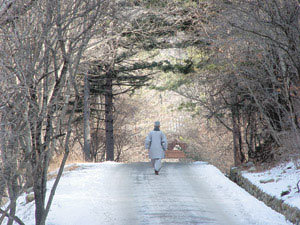Where Manhaes Traces Remain as Well as Those of Former President
Where Manhaes Traces Remain as Well as Those of Former President
Posted February. 11, 2004 23:40,

The trail leads to Baekdam Temple in the inner Mt. Sorak in the middle of winter. From the box office in the foot of the mountain to Baekdam Temple spreads a trail of seven kilometers around the valley on the left side. It is covered with pure white snow. It is already middle of February. The temperature and scenery is still resembles that in the middle of the winter, but I could feel the spring warmth and softness in the sunbeams. Hares foots prints, looking for food in the snow, are scattered on the snow-covered hills of the mountain. Still, the sound of the water flowing below the ice in the valley is still loud. The winter seems to have gone farther like an old song.
The baekdam temple valley is in the heart of the inner Sorak, carrying the water from Daechung (Great Blue), the major peak in the mountain. The water flows around the Daechung peak and comes into the Gaya-dong valley. This water meets waters from Suryom-dong and runs through Gomgol and Gilgol until it reaches Heukson-dong near Baekdam Temple. The water here, finally arriving in the Baekdam valley, now runs directly to Yongdae-ri as it has been all those years from the ancient times.
The trekking leads us up to the winter temple of Baekdam. The trekking does not set its goal to visit the temple but rather to enjoy the scenery in the course of it. The road is not that steep and winds as if a dragon traced by. There is no traffic except buses going up to the temple. The place is still covered with snow and ice still making the beautiful scenery in the middle of winter.
The valley has many stories. A man thought it had good fengshui and dug out around the valley and found a coffin there. A crane has flown away from the opened coffin and gave the part of the valley as Crane Rock Valley. A Buddhist monk threw away a dead body of a bachelor somewhere in the valley. When the monk performed a ceremony to lead the soul to heaven, a blue fog arose, which gave the name Choengnyong-dam.
The valley experienced the tragedies of the Korean division in the late 20th century. Former president Chun Doo-hwan escaped to the temple for two years and one month from the public. The stories covering his stay there still popularly appear on the newspapers.
Even without the news stories, people in the temple speak often of the name Chun Doo-hwan. As people think of Kim Dae-sung when speaking of Bulguk Temple, people think of Chun whenever speaking of Beakdam Temple. But people forgot one thing. The temple was famous for Monk Manhae (1879 ~ 1944), a.k.a. man of letter Hahn Yong-woon. He was ordained in the Baekdam Temple and worked on spiritual reforms of the Korean Buddhism. He wrote the book, Revitalizing Theory of Josun Buddhism and also Silence of Nim. The temple was the working field of his literary and scholarly works.
People skip the center celebrating Manhae and only look into Yosa-chae, where Chun Doo-hwan has stayed. They have forgotten the time before in the history. The Manhaes statue is ignored, and the room with only an old calendar left on the wall is drawing all the attention. People go down the mountain having fulfilled their goal of seeing the room in the temple.
When a person visits a temple, they always go first to bow to the Buddha in the main hall. But this is an exception in this temple. People are busy looking up the sign with calligraphy by the former president rather than gazing into the Buddha.
The stories created around the temple and the president changed the appearance of the temple as well. The refined beauty of the old temple disappeared as well as the memories of Manhae. Only the mundane and profane remained. However, the dharma handed down for centuries remains in the monks of the temple. Still Buddhists, young or old, walk up the trail to visit the monks and the Buddha. Isnt this thanks to the monks who have practiced in the temple from ancient times and convert the energy from the mountain into the energy of the nation as well the as the words of Buddha carried by Manhae to the nation?
summer@donga.com







